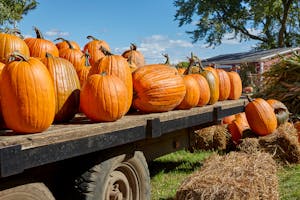- 6 minute read
- Business Management Tips
- Digital Marketing
- Industry Insights
All Skill Levels
Get a behind-the-scenes-look into FareHarbor's 2024 season

The shoulder season is the time between your peak and low season — as well as the time between your low and peak season. That’s right, with two shoulder seasons per year, you should definitely be capitalizing on them!
Keep in mind that your specific shoulder season can differ from another operator’s based on your activities, location, target audience, the weather, and more.
Traveling during these months has become increasingly popular for people across the globe. Cheaper flights and accommodations and less crowded destinations? Sign us up!
It’s easy to see why travelers love the shoulder season! And from your perspective as a tour and activity operator, this time of year can help you gain more bookings and increase revenue.
This guide will cover why the shoulder season is enticing to travelers and specific ways you can make the most of these months.
The peak season is a favored time to travel for a reason. Kids are out of school and the weather is generally cooperative (snowy for winter sports and warm for almost every other activity). But, with that comes more expensive prices and so. many. people.
That’s where the shoulder season shines. Below are a few of the top reasons that customers love exploring during this time of year.
If you want to lean into shoulder season, there are several strategies that can set you on the right path. But before diving in too quickly, it’s vital to learn what the shoulder season is like for your business in your area. Here are a few things to consider:
Once you have answered these questions, you can plan your tactics to extend your season. Go into this time prepared and ready to create opportunities and try something new.

Seasonal carnivals and festivals or event-based activities can easily generate revenue in the shoulder season. Consider launching a sale or hosting a celebration during holidays like Labor Day, Halloween, fall break — or on the flip side Memorial Day, Mother’s Day, or spring break. All can help generate extra bookings.
If your area has a big concert, fall festival, or conference — think about piggybacking off the local event to help grab last-minute reservations.
Your target audience in the shoulder season may differ from your peak season. For instance, if you attract a lot of families during the summer months, you may have to start marketing to couples and older travelers once children go back to school.
You can always run a marketing campaign that specifically targets locals, especially if the amount of destination travelers falls dramatically in your area. This is a great time to work on your local SEO to capture those bookings all year long!
Use the benefits of the shoulder season to your advantage! When you market your offerings during these months, change your messaging to include perks like “less crowded”, “less expensive”, “20% off”, or “smaller group sizes” to entice travelers to visit your business. This can help you target a new audience profile or location.
 Pro Tip: Add the shoulder season perks as a public headline in your Dashboard. This will make the added benefits very clear to your customers when they are visiting your site.
Pro Tip: Add the shoulder season perks as a public headline in your Dashboard. This will make the added benefits very clear to your customers when they are visiting your site.
To better capitalize on shoulder season customers, try to be as accommodating as your business model allows. You can adjust your cancellation policy, accept same-day bookings, or offer online rebooking.
Consider adjusting your online booking cutoff time to allow for last-minute customers to secure their spot on your tour.
As previously mentioned, this is also a wonderful time to offer a shoulder season discount. You would be surprised with what even a 10% discount can do for bookings!
There are plenty of reasons customers love the shoulder season and using them to your advantage can be a great way to raise your bottom line. For more information on the shoulder season, watch our webinar and read more in this article.